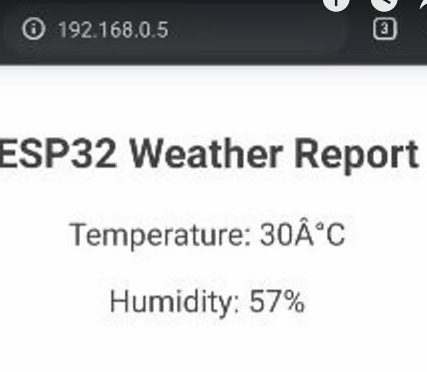Read the statement by Michael Teeuw here.
Display different Roomtemperature on MagicMirror
-
@sdetweil thx
-
@Xilef
ESP8266 is a good choice. I prefer ESP32 cause it has more power but does not need that much more energy. You have a lot more GPIOs with a ESP32 than a with the ESP8266.I can provide you a ESP32 sketch which is ready to flash and only needs the Wifi-SSID, Wifi-Password and the MQTT parameters configured.
I use the Arduino IDE to flash the boards. -
@wishmaster270 thanks
As I understand it, something like this is my target:

And i would need:
- ESP32
- DHT11-Sensor Problem with this Sensor is the accuracy i think, but if it works I can swap them out I guess
- BreadBoard
And as Powersupply something with 5V and 1-1,5A right?
I would probably do it like this guy on youtube https://www.youtube.com/watch?v=ebJpXs2-WgM&list=PLUwa0e4GQGhS6KCSbLAQGog4_Z7eIWOm3&index=3
And from the ESP32-Website the MagicMirror should be able to read the data and display it
-
@Xilef
You need a ESP32 ( I use a D1 Mini but nearly everyone should be fine)
You need a Temperature and Humidity Sensor (BME280 and HTU21 are a lot more accurate and use I2c to communicate with the controller.
A Power supply with 5V 1A should be more than enough.That’s how I display my values…

The first three are ESP32 the others my thermostats.
-
nice…
-
@wishmaster270 Thats exactly what i had in mind
The BME280 sensors on amazon are a litte expensive so Im think Im order 3 form this shop They have 5 Pins but I think this will work to, on Aliexpress its even cheaper but i have no experience with the shop, and 1-3€ difference is ok i guess
And I wanted to ask what power supply you use e.g. just a cell phone charger?
I think im gona go with this one and hope that it doesnt explodeSo if I have everything right this is my shopping list:
ESP32
BME280
Power Supply
BreadBoardAnd then I just have to figure out the programming
-
Edit: With Power Supply i mean this one: https://www.amazon.de/gp/product/B08LMFBV55/ref=ox_sc_act_title_2?smid=A1XVC08L2WVJCV&psc=1
-
@Xilef Hi, the list sounds good. I use old mobile chargers to power the boards. I have heard that some had problems with mobile chargers but I had no problems for years now.
-
Hey im back @wishmaster270
my parts arrived, and after 5 hours of Troubleshooting i was able to achieve this: (with the help of this tutorial)

Now i need just a little bit help to display the Temperature and Humidity on my mirror
-
@Xilef
Hi,
thats great news.
The screenshot shows that you setup the ESP32 and the sensor correctly.
The main problem is that the ESP now displays a webpage.
There are two possible ways now. Either you embed the webpage (as it is) into the mirror with a module like MMM-EmbedURL or to get the ESP to display the data machine readable.
Maybe the sketch you flashed to the ESP already contains a way to read the data in a different format? Which one did you use?Edit: I think it is this one, am i right? Then there is no easy way.
I think i can provide a sketch that is more “mirror friendly” but you will need to set a static IP for the ESP. Is this ok for you?You will need to change to your needs:
- ##ADD_WIFI_SSID_HERE
- ##ADD_WIFI_PASSWORD_HERE
- IPAddress local_IP(192, 168, 0, 2);
- IPAddress gateway(192, 168, 0, 1);
- IPAddress subnet(255, 255, 255, 0);
- IPAddress primaryDNS(192, 168, 0, 1);
#include <WiFi.h> #include <Wire.h> #include <Adafruit_Sensor.h> #include <Adafruit_BME280.h> const char* ssid = "##ADD_WIFI_SSID_HERE"; const char* password = "##ADD_WIFI_PASSWORD_HERE"; //ENTER STATIC IP OF THE ESP32 BOARD HERE IPAddress local_IP(192, 168, 0, 2); IPAddress gateway(192, 168, 0, 1); IPAddress subnet(255, 255, 255, 0); IPAddress primaryDNS(192, 168, 0, 1); IPAddress secondaryDNS(8, 8, 8, 8); Adafruit_BME280 bme; WiFiServer server(80); void setup() { Wire.begin(); Serial.begin(115200); if (!WiFi.config(local_IP, gateway, subnet, primaryDNS, secondaryDNS)) { Serial.println("STA Failed to configure"); } Serial.print("Connecting to "); Serial.println(ssid); WiFi.begin(ssid, password); while (WiFi.status() != WL_CONNECTED) { delay(500); Serial.print("."); } Serial.println(""); Serial.println("WiFi connected!"); Serial.print("IP address: "); Serial.println(WiFi.localIP()); Serial.print("ESP Mac Address: "); Serial.println(WiFi.macAddress()); Serial.print("Subnet Mask: "); Serial.println(WiFi.subnetMask()); Serial.print("Gateway IP: "); Serial.println(WiFi.gatewayIP()); Serial.print("DNS: "); Serial.println(WiFi.dnsIP()); if (!bme.begin(0x76);) { Serial.println("Couldn't find sensor!"); while (1); } server.begin(); } void loop() { float temp = bme.readTemperature(); float tempf = temp * 1.8 + 32; float rel_hum = bme.readHumidity(); WiFiClient client = server.available(); if (client) { Serial.println("New Client."); client.println("{"); client.print(" \"temperature_c\": "); client.print(temp); client.println(","); client.print(" \"temperature_f\": "); client.print(tempf); client.println(","); client.print(" \"humidity\": "); client.print(rel_hum); client.println(","); client.println(" \"error\": false"); client.println("}"); client.stop(); Serial.println("Client disconnected."); Serial.println(""); } delay(100); }You can use netcat to fetch the data:
/bin/nc -w3 THE_IP_OF_THE_ESP 80And the result will be something like:
{ "humidity": 32.61236572265625, "temperature_c": 25.50150878906249, "temperature_f": 77.9027158203125, "error": false }This kind of JSON object then can be read by my MMM-Temperature module.

